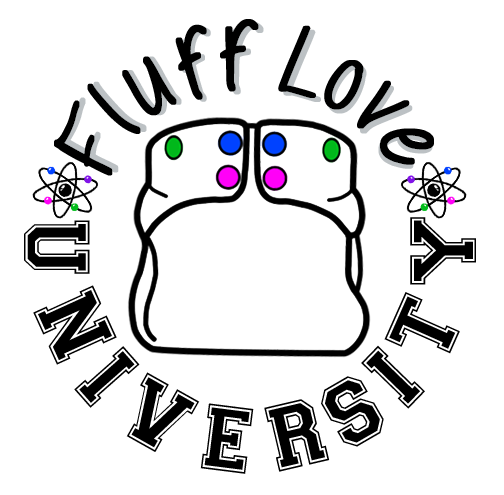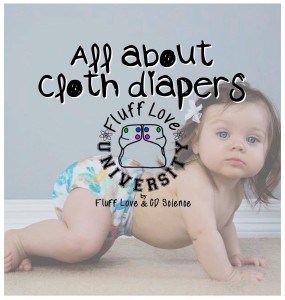
Ever get confused by all of the different diapers out there? Well, you’re in the right place! Freshman Orientation will give you an overview of the many different options out there for diapering your babes.
You can also check out our Cloth Diapering Cheat Sheet for an overview of essential cloth diaper information.
How many cloth diapers do I need?
That depends on a few variables, like the age of your baby, how heavy a wetter your baby is, and how frequently you want to do laundry. We usually suggest the following size stashes:
Newborn -- Minimum 12 - 15 changes to do laundry every day; 24 - 36 to do laundry every other day.
3 Months and older -- Minimum 10 - 12 changes to do laundry every day; 20 - 30 to do laundry every other day.
What types of cloth diapers should I buy?
You'll have to experiment to find out! Different people like different styles and brands, and what works for one baby may not be a great choice for another baby. Whenever possible, we always recommend trying out at least two or three different types of styles or brands before committing to a whole stash. Some online retailers do trial or rental programs; these can be a good way to experiment. To learn more about specific brands of cloth diapers, including user ratings, check out our cloth diaper brand index.
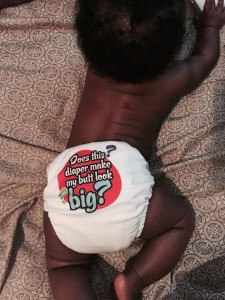

All in ones (AIOs) are one of the most convenient diaper options, particularly for non-CD savvy caregivers! These diapers are the most similar to disposables. There’s no stuffing, no folding, no messing around. Just wrap it around baby and snap or secure the aplix. Many parents like having at least a few AIOs in their stash, since they're so easy to use.
An AIO consists of a waterproof outer layer (typically PUL or TPU) and an attached absorbent inner layer, which can be made of cotton, bamboo, hemp, charcoal bamboo, microfiber topped with cotton, velour, or other similar fabrics. Most AIOs are one-sized, meaning they'll fit babies from about 12 - 30 pounds. AIOs also come in newborn sizes. A few brands of AIOs are still sized (small, medium, large, etc), but this style is less common nowadays.
Like pocket diapers and covers, AIOs can be secured with snaps or with aplix (Velcro).
The pictures below show the insides and outsides of four different cloth diapers (clockwise from top left: A Blueberry Simplex, a Bumgenius Freetime, a Nickis Bamboo AIO, and a Padded Patootie). Though each is constructed in a slightly different way, they're all similar in that the main absorbent portion of the diaper is attached to the waterproof outer shell. Check out the video at the bottom of the page to get a closer look at AIOs.
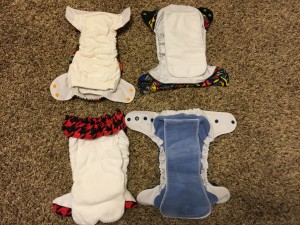
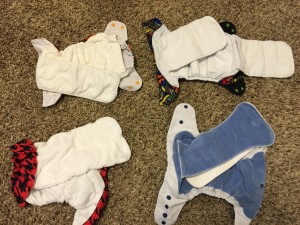
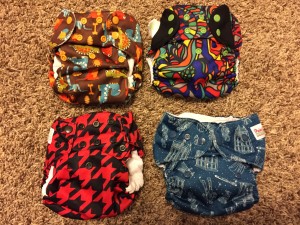 AIO Pros:
AIO Pros:
- Super easy to use -- just snap or Velcro it onto the babe.
- Great choice for grandparents or babysitters, or for changes out and about.
- Can be very trim.
- Many cute styles, colors, and prints.
- Some styles have pockets or snaps that allow you to add additional absorption.
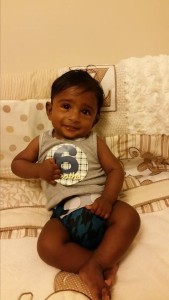
Nicki's Bamboo AIO in Blue Razz Chevron
AIO Cons:
- Some AIOs take a longer time to dry, since there are many layers of fabric sewn together.
- These are generally the most expensive style of diaper.
- AIOs have to be washed after each use.
- May not be a good overnight option.
- Some styles make it less easy to customize absorption.
https://www.youtube.com/watch?v=UtHgSRRdlAA&feature=youtu.be
Some popular brands of AIOs:
Alva AIOs, $6.40
Blueberry Simplex, $28.95
Bumgenius Freetimes, $19.95
Bumgenius Elementals, $24.95
Chelory AIO, $32.95
Grovia, $23.95
Happy Flute AIOs, available through coops, approximately $8
Moraki,$27
Nicki's Bamboo AIOs, $14.95
Ragababe, $34.95 (sells secondhand for more than retail)
Smartbottoms, $25
Thirsties, $18.95
Tots Bots Easy Fit, $24.95
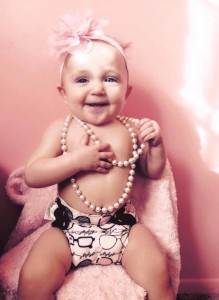
Bumgenius Freetime AIO in Audrey
All in two/hybrid (AI2s) systems offer some great features. They come in two pieces – inserts and covers. Most have offer either snap-in, lay-in, or disposable inserts. The covers can be wiped and reused throughout the day (unless poo escapes!) with fresh inserts. They are often trim and offer a variety of options within one system. Check out the video at the bottom of the page for a closer look at AI2 systems.
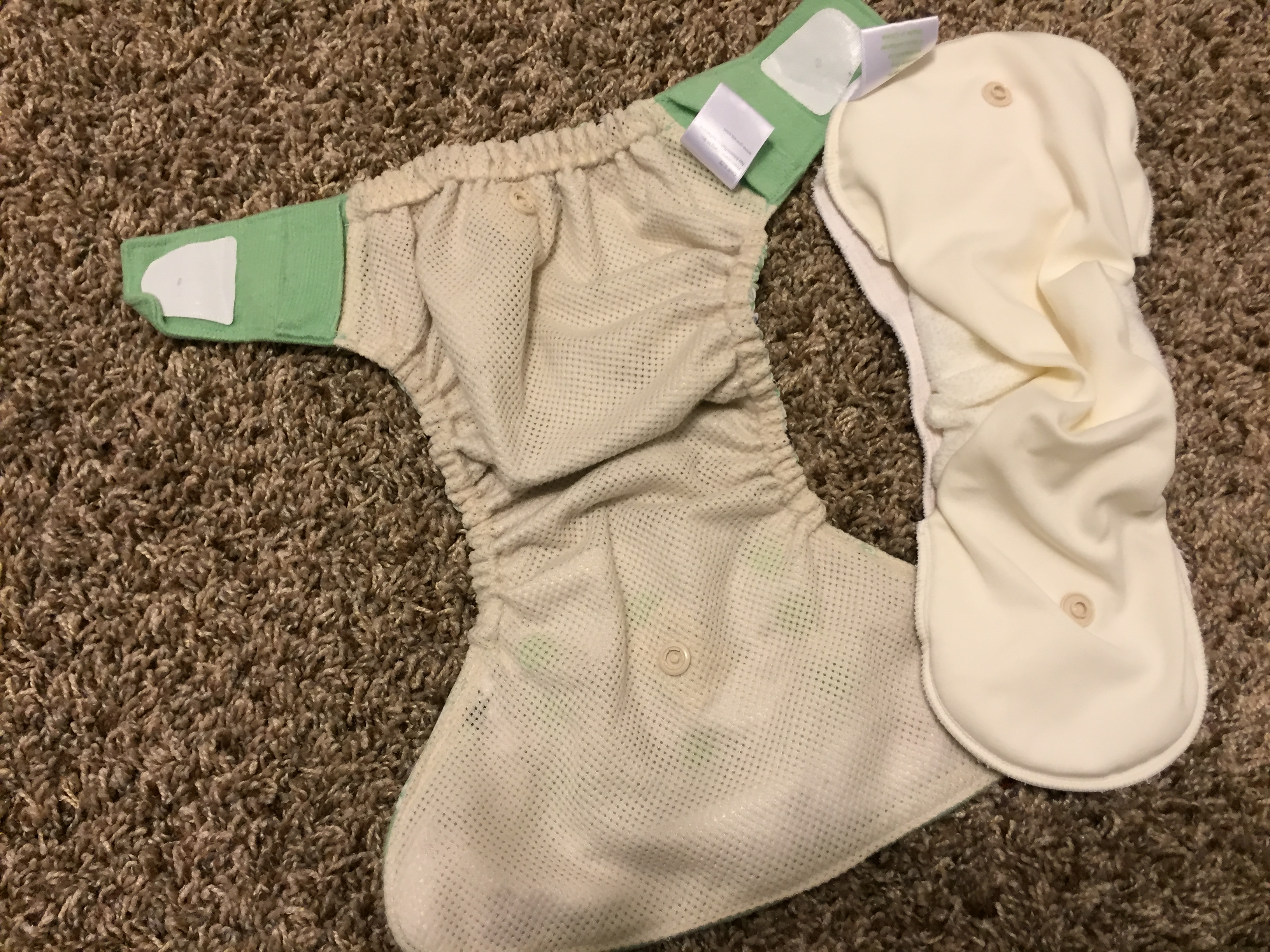
An AI2 consists of two parts -- an outer water-resistant shell, and an absorbent insert. Inserts can be cloth or disposable, and often snap into place.
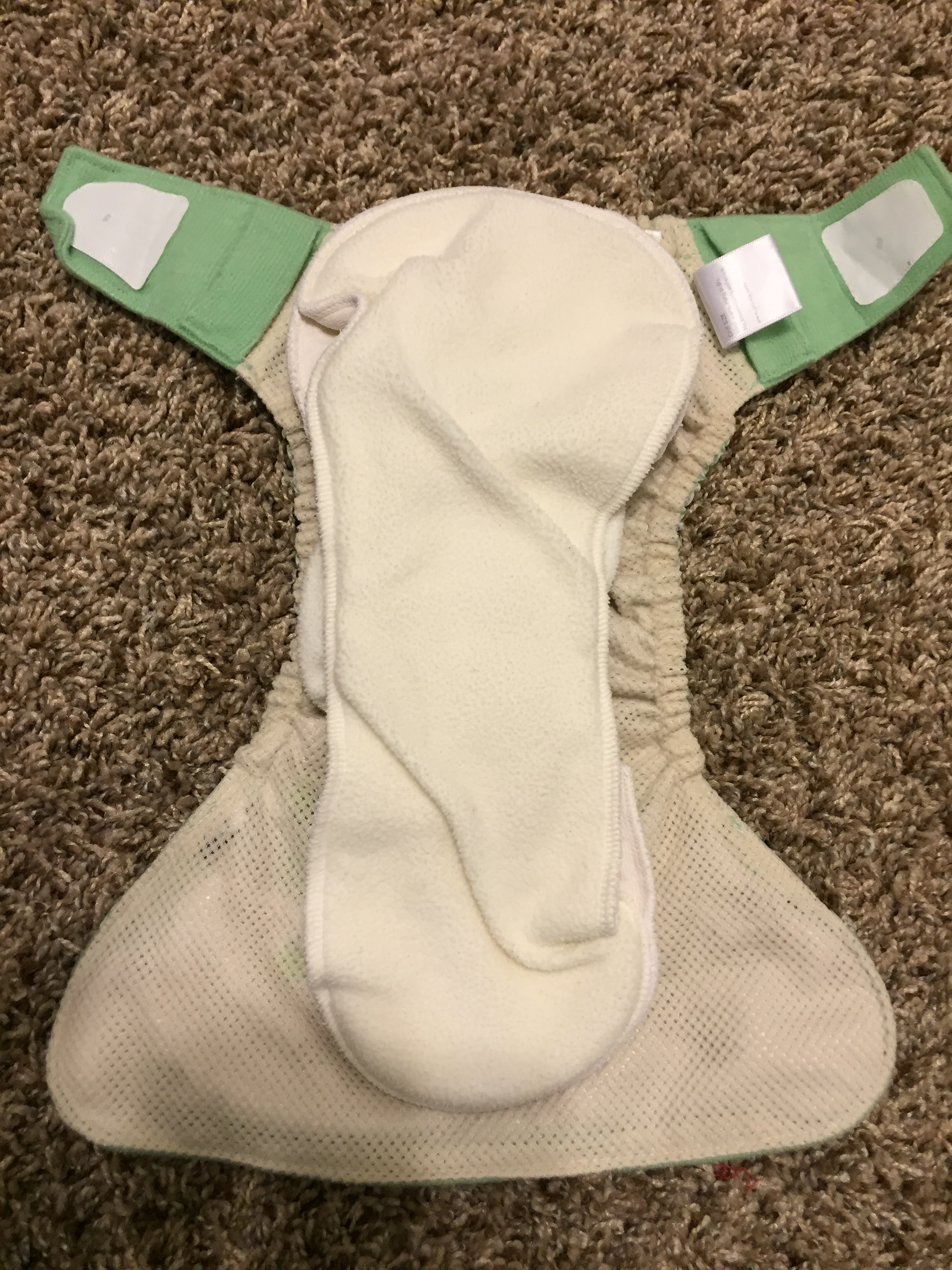
When the insert is pre-snapped, an AI2 is as easy for babysitters and grandparents as an all in one diaper.

When the diaper is wet, you can usually toss the old insert into the wetbag and reuse the cover with a fresh insert. (Featured diaper: Grovia AI2 in Pudge print)
- Since the covers can be reused, they can be an economical system.
- Often very trim.
- If the inserts are snapped in ahead of time, they're as easy to use as AIOs.
- Shells come in many cute prints and colors.
- Often fairly quick to dry, though some inserts can be slow drying.
- Some systems have high-absorbency nighttime inserts
- Some systems make disposable inserts, which can be a convenient feature for travel.
- Lay-in systems with tuckable covers, such as Flips, can be used with prefolds, flats, or flour sack towels in addition to designated inserts.
AI2 cons:
- Sometimes the inserts are expensive enough that the system isn't any cheaper than an AIO.
- The inserts may not be good at containing poop.
- Changing out the inserts requires an extra step.
- Often not a great nighttime option.
- Snap-in systems make it difficult to customize absorbency.
- With lay-in systems, inserts may bunch or move.
Some popular AI2 brands include:
- Applecheeks, cover $20, inserts $5 - $11.50
- Best Bottoms, cover $16.95, inserts $3.95 - $6.95
- Bumgenius Flips, cover $14.95, inserts $5 - $12.50
- Chelory, cover $24.95, inserts $8.25
- Grovia, cover $16.95, inserts $8.50
- Moraki, cover + 1 insert $27, extra inserts $5
- Ragababe 2-Step, cover + insert $39.95
- Softbums, cover $21.95, inserts $3.95 - $7.95
- Thirsties, cover $12.75, inserts $6.75 - $8.75
http://youtu.be/A6gfTKPYimA
Flats, prefolds and fitted diapers require a cover to be waterproof. Covers are generally made from either PUL, wool, or fleece.
PUL or TPU covers
Many diaper covers are made from a thin, thin, water-resistant fabric such as PUL or TPU. (PUL is short for polyurethane laminate, and TPU stands for thermoplastic polyurethane). These fabrics don't absorb liquid, but they do provide a water-resistant backing over flats, prefolds, or fitteds. They also provide an extra layer of protection against the dreaded poop-splosion. To use a PUL or TPU cover, simply put on the diaper underneath, and then snap or Velcro the cover on over the diaper. While some covers come in multiple sizes, most covers nowadays come in just two sized -- newborn, which fits babies from about 5 - 16 pounds, and one sized, which fits babies from around 10 pounds till potty training. Many covers that are coming out nowadays are "tuckable", meaning they have two flaps on the inside to hold an insert. You can fold a flat or prefold into a rectangular shape and simply lay it inside the cover. This is a fantastically quick, easy, and absorbent system.
Wool
Wool covers may seem intimidating at first, but they're a great choice for day or night use. Wool is antimicrobial, somewhat self-cleaning, water-resistant, and can absorb 30 percent of its weight in liquid. Wool covers can be machine or hand-knitted wool, made from interlock (felted wool) or upcycled from wool sweaters. For many people, a wool cover over flat or fitted diaper is the most bulletproof overnight option. Wool can come in a soaker (cover), shorties (short pants), or longies (long pants). Some people use wool shorties or longies as clothing or pajamas. Wool needs to be hand washed and lanolized, and can take a day or two to dry. If it's only wet, you can go 2 - 4 weeks between laundering. However, if needs to be washed if it gets soiled. Because of this, many people choose to start wool after their baby is out of the newborn phase, since newborn poop is runny and more likely to get on covers. See our page on wool care for an overview of washing and lanolizing wool.
Fleece
Fleece is water resistant and easy to use. Unlike wool, you can throw fleece into the washer and dryer, making it a nice option for newborns. However, unlike wool, you do need to wash it with every use. Like wool, fleece comes in soakers, shorties, or longies and can also be used as clothing or pajamas. Fleece covers are usually made from anti-pill or windpro fleece.
Fitted diapers are a great choice for overnight, car rides, and for babies who are heavy wetters or who are sensitive to synthetic fibers. While pocket and AIO diapers are absorbent only in the wet zone, or crotch, fitted diapers are absorbent all the way around. They usually snap or Velcro shut, similar to an AIO. However, they generally require a cover to be fully waterproof. Hybrid fitteds have a layer of non-absorbent fleece that allows them to sometimes be used without a cover.
Fitteds are generally made from cotton, bamboo, or hemp. Cotton is the least absorbant and is generally best for daytime use. Bamboo is quite absorbent and very soft. Hemp is the most absorbent, but can be somewhat scratchy. There are many extremely cute fitteds made from a wide variety of prints, and some can be very collectable.
Fitteds are also a great choice for newborns because they're so good at containing newborn poop. Green Mountain Diapers workhorse fitteds are a very popular choice for a newborn stash.
For many people, a good fitted under a wool cover is the most reliable overnight option. Fitteds are great for tummy or side sleepers because they absorb around the hips and belly, preventing leaks. Additionally, a good fitted can be absorbent enough to hold a whole night's worth. See our page on
overnight diapering for more info.
Fitted diaper pros
- Very absorbent
- Great for overnights and car rides
- Good choice for newborns
- Can be extremely cute
Fitted diaper cons
- Usually require a cover
- Can be bulky
- Not great for babies who are sensitive to wetness
- Some brands are expensive
- Some fitteds that are made out of cute fabrics can fade in a bleach soak.
Some popular brands of fitteds:
- Assunta
- GMD workhorse
- Goodmama
- Maplebean
- Pooters
- Sbish overnight bamboo fitteds
- Tots Bots Bamboozles
- Wonderful Bambino
Flats are simply large single squares or rectangles of fabric. When you think of old school cloth diapers, you're thinking of flats. They may seem intimidating and hard to use, but they're actually easy, inexpensive, absorbent, and all around awesome additions to anyone's stash. They're versatile, easy to customize, and super easy to clean. Flats are the only truly one-sized diaper -- you can fold them to fit a day-old newborn, or a preschooler overnight. Flats require a cover to be waterproof.
Ways to use flats:
- Flats can be folded around baby and secured with pins, snappis or boingo clips. There are many online tutorials for how to do basic flat folds, such as the kite fold, newspaper fold, origami fold, or newborn kite fold. Check out the video below for instructions. It takes a few seconds longer to fold the flat, but once you have it on, it's very absorbent and reliable. Folding in this way is great for overnight use because it provides absorbency all around the baby's hips and belly. The flat needs to go under a PUL, wool, or fleece cover to be waterproof.
- Flats can be "pad-folded", or folded into a rectangle, and laid into a cover. This is a super easy system. You can padfold a bunch of flats ahead of time. To use, simply lay the flat into a diaper cover. Many covers nowadays are "tuckable", with flaps on either end to hold an insert in place. When the diaper is wet, you can throw the flat into the diaper pail, wipe the cover, put in a new padfolded flat, and replace the cover. Padfolding is a very absorbent option because you create 12 layers of fabric in the fold. To see how to padfold, watch the video below.
- Flats can be padfolded and stuffed into a pocket diaper. Though not quite as trim, they're much more absorbent than many pocket diaper inserts.
Types of flats: There are many types of flats that you can buy from cloth diaper sellers.
- Cotton flats -- inexpensive and absorbent
- Bamboo flats -- slightly more expensive, more absorbent than cotton, and very soft
- Hemp flats -- the most absorbent, but not quite as soft as bamboo
Additionally, you can use other household textiles as flats. Flour sack towels (FSTs) are a fantastic way to cloth diaper on the cheap. You can buy FSTs in the dish towel section of stores like Wal-Mart of Target. They're generally sold in packs of five for $5, or $1 each. FSTs work just as well as flats for a fraction of the price. Another flat alternative is receiving blankets. You can use any normal receiving blankets that you have laying around the house, or you can buy them at thrift stores for about 25 cents each. You can also make your own flats from any fabric you happen to have on hand, including old tee shirts.
Ways to customize the absorbency of flats: It's very easy to add absorbency to flats. Some options include:
- Layering two flats together and folding as normal
- Folding one flat and layering a second padfolded flat into the wetzone
- Adding any inserts you have on hand (note that microfiber inserts can't touch the baby's skin and need to be wrapped in another fabric.)
Pros of flats:
- Inexpensive (especially if using FSTs).
- Very easy to clean, since they're a single layer of fabric. Best choice if you're handwashing.
- Versatile and easy to customize absorbency.
- Good choice for overnight, especially under a wool cover.
- The only truly one sized diaper.
Cons of flats:
- They require the extra step of folding.
- Can be intimidating and have a little bit of a learning curve.
- Some high end flats can be relatively expensive.
- Not the most trim option.
- Require a cover.
Pocket diapers are one of the most popular styles of diapers. A pocket consists of two parts -- a water resistant shell, and an absorbent insert. The shell is made up of a PUL/TPU water resistant layer on the outside, and a stay dry layer (often microsuede/microfleece) on the inside. In between the two layers is a pocket that can be stuffed with an absorbent insert. Most pocket diapers come with microfiber inserts, although higher end versions may have bamboo inserts. Additionally, many people use other absorbent materials for inserts, such as prefolds, flour sack towels, flats, receiving blankets, etc. A great advantage to pockets is the ability to customize the absorbency. If you have a small baby or light wetter, a single microfiber insert will likely suffice. If you have a toddler or heavy wetter, you can add additional inserts or stuff with more absorbent options – charcoal bamboo inserts, prefolds, flats, hemp, bamboo, etc. Many people like to combine inserts; for example, they might wrap a microfiber insert in a flour sack towel, or put a hemp insert on top of a charcoal bamboo insert. A major disadvantage of pocket diapers is that the insert has to be stuffed into the pocket after washing, which can be a little time consuming. However, once the diaper is stuffed and ready to go, it's as easy to use as an AIO. After the baby wets or soils the diaper, the entire pocket diaper, both shell and insert, has to be washed. Some brands of pocket diapers are extremely inexpensive (about $5) while other brands can cost more than $20.
Pocket diaper pros:
- Once the diaper is stuffed, it's very easy to use
- It's easy to adjust the absorbency by adding additional or more absorbent inserts
- Can be very affordable
- Fairly trim
- Good for babies who are sensitive to wetness
Pocket diaper cons:
- Stuffing the inserts can be time consuming
- After the diaper is soiled, the entire thing, shell and insert, has to be washed
- Often not a great choice for overnights
- Many people find that the microfiber inserts that commonly come with pocket diapers are leaky
- Some babies are sensitive to synthetic fibers, especially microsuede, which commonly is used for the stay-dry lining
Some popular brands of pocket diapers:
Very inexpensive:
- Alva
- Assunta
- Happy Flute
- Kawaii
- Sunbaby
Moderately priced to high-end:
- Applecheeks
- Blueberry
- Bumgenius 4.0s
- Charlie Banana
- Glowbug
- Lalabye Baby
- Nicki's
Some good options for pocket diaper inserts:
Microfiber (MF) inserts are fully synthetic, and the most common inserts. They are white, and have extraordinary wicking properties. As such, they are the only inserts that CAN NOT go against baby bums, as they will draw the moisture right out of the skin. There are companies that make inserts with MF on one side, and then something like microfleece on the other side, which CAN go against baby. Microfiber absorbs VERY quickly. Charcoal Bamboo (CBI) are bamboo on the outside, and microfiber on the inside. They are black in appearance, with or without stitching in the middle. The bamboo on the outside of this insert means it can go directly against baby bums. It absorbs relatively quickly, though slower than microfiber. Bamboo inserts are effective and very absorbent, but absorb much slower than CBI/ MF. They are extremely soft and usually a mix of bamboo (rayon) and cotton. Hemp inserts are quite absorbent, but like bamboo, absorb very slowly. They do well paired with something that absorbs faster, or are great for children who don’t ‘flood’. Like bamboo, they are very soft, and a mix of cotton and hemp. In addition to designated inserts, you can also use flats, prefolds, flour sack towels, or receiving blankets to stuff pocket diaper. In fact, these are often the most absorbent and reliable options.
This page is under construction. Check back soon for more info!
Prefolds – Prefolds are rectangles of fabric sewn together with more layers through the middle of the diaper. They come in many sizes and options – newborn, baby, toddler, bleached, unbleached, etc. These can be folded around baby and held together with pins, snappis or boingo clips. They can also be trifolded and laid into covers. Prefolds can be folded in many different ways to customize the fit and absorbency. They can also be stuffed into pockets
For more videos, check us out on
Youtube!Here's our tutorial on diaper snaps:
